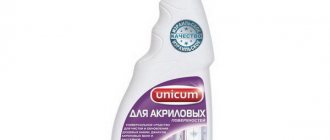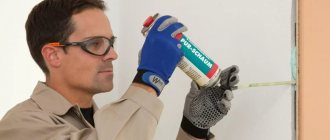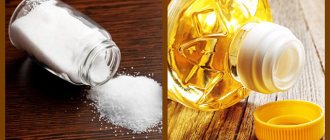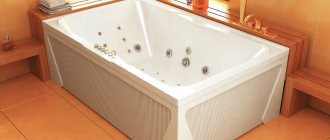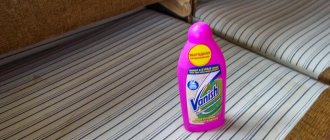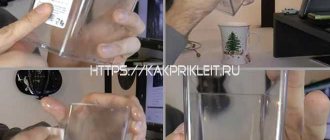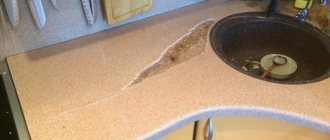Preparing to remove from the bath
If the sealant is fresh, then removing it will not be difficult , but to remove the hardened isolate you will have to make an effort, since it adheres tightly to the surface. New sealant cannot be applied to old material.
You can clean it in 2 ways: mechanical and chemical. In severe cases, these two methods must be combined.
The choice of cleaning method is influenced by what type of sealant was used to seal the bathroom. Silicone sealants come in 2 types:
Acidic. They have a characteristic odor reminiscent of vinegar essence.
It contains aggressive components, so when working with it you need to thoroughly ventilate the room. This is especially true in the case when its removal will be carried out using a chemical method. Preference should be given to formulations containing acid.- Neutral. They have almost no smell and do not contain any caustic substances. Such sealants can be safely removed both chemically and mechanically. They can be removed with acetone and other organic solvents.
Acrylic sealants are easier to clean off than silicone sealants. This material can be pryed off with a utility knife or blade. It also reacts well to solvents such as gasoline, acetone and vinegar.
Another type of sealant is siliconized . They are a combination of acrylic and silicone mixture. Such compositions are moisture resistant and harmless to humans. You can remove them in any way.
When starting to remove the material, it is recommended to seal the bathtub with masking tape. This will protect it from scratches if your hand accidentally falls off. You need to prepare tools and chemical compositions in advance.
How to wash your hands of silicone sealant
Mechanical removal of dried silicone from hands is complicated by real damage to the skin. The sealant is deeply absorbed into the pores of the skin and hardens there, so it can only be wiped off fresh. Dried silicone is removed with a solution of vinegar, alcohol, acetone, white spirit or galoshes. Methods with a plastic bag and soap, as well as a tandem of vegetable oil and washing powder, are effective.
Due to the fact that it is almost impossible to remove dried silicone from your hands, a person immediately begins to look for how to wash the sealant off his hands with minimal harm to the skin. You need to be especially careful when using various products to remove silicone - it is worth remembering that this open and unprotected skin can suffer as a result of experiments.
Dangerous influence of sealant
Regardless of the composition of the sealants, when it comes into contact with exposed human skin, it causes an unpleasant allergic reaction. The situation is aggravated if the sealant contains a high concentration of acetic acid. Even with short-term contact, it can cause a chemical burn that is severe enough to require treatment at a medical facility for rinsing and dressing.
The danger is the main property of the sealant to penetrate any surface and harden firmly in it, turning into a very elastic waterproof material. The skin is a porous surface that is well saturated with the sealant before it hardens. Mechanical removal of the frozen layer of silicone can lead to serious damage to the skin, which must be carefully treated. The fingertips are especially sensitive to such damage.
To prevent the sealant from getting on exposed skin, it is recommended to use durable rubber gloves that do not absorb silicone, allowing it to pass through to the skin.
Working with silicone with gloves will protect your hands from getting dangerous products on your skin.
Note! It is also advisable to wear closed clothing to protect other areas of the body from the harmful effects of silicone.
It doesn’t hurt to ask in advance how to clean clothes from silicone sealant stains.
Methods and means of removing sealant
There are two ways to wash acrylic or polyurethane sealant from your hands: mechanical and chemical. Mechanical is very problematic if the sealant completely hardens on the hands, because after tearing off the silicone, painful damage will remain on the body.
Mechanical removal of sealant from hands can be painful
If the sealant is still fresh, you can quickly wipe it off with a clean rag. Even if something has already dried out, the methods described below will definitely help you painlessly and effectively wipe the sealant off your hands.
Soap and plastic bag
Silicone adheres very well to a plastic bag in any form. The advantage of this method is its accessibility - such a bag can be found anywhere. They need to wipe their hands in places that are smeared with silicone.
Polyethylene interacts well with silicone
The sealant will gradually begin to adhere to the bag and remain on it. Residues on hands are removed with regular soap or detergent under running warm water. If necessary, the procedure is repeated several times until the silicone completely disappears.
Soap effectively removes sealant residues
Solvents
If soap does not help wash off silicone residues from your hands, you need to resort to more radical measures - solvents. Regardless of the type of sealant and its composition, it is in any case susceptible to the action of aggressive solvents such as alcohol or acetone.
Acetone works great for sealant that has dried on your hands.
To clean your hands, you will need a clean, dry rag, cotton wool or cotton pad. The selected material is soaked in liquid, after which dirty hands are wiped with it in places of contamination.
Advice! It is better not to apply the solvent to clean areas of the skin, because it can also burn the skin and add even more problems.
Under the active chemical action of solvents, the frozen silicone will begin to turn into a cloudy liquid and gradually be absorbed into the cloth or cotton wool. It is necessary to replace the material with a clean one every time the previous one is thoroughly saturated with dissolved silicone - there is a chance of smearing it on clean skin, and you will have to wash off the sealant from your hands again in large volumes.
As an alternative, white spirit paint thinner, which actively dissolves sealants of any kind, as well as highly purified gasoline “Galosha” are excellent. The method of use is similar to that described above.
White spirit is an analogue of acetone when cleaning hands from silicone
White spirit can also be used to remove silicone from regular and frosted glass, tiles, and stained bathtub surfaces.
Vinegar solution
If you don’t want to burn your already damaged skin, you can use a milder solvent – table vinegar.
Table vinegar for preparing the solution
The usual concentration of 9%!b (MISSING) will be enough in this case - the vinegar can be diluted equally with ordinary warm water. You need to thoroughly spray your hands with the prepared solution; the sealant will very quickly begin to dissolve and dissolve into water.
After treating with vinegar, you can use toilet soap, which will wash away the remaining silicone sealant and vinegar from your hands, and also moisturize the skin and relieve it from irritation.
Note to the owner! Find out how to use regular vinegar to descale your kettle and remove grease stains from your refrigerator.
Vegetable oil and washing powder
Slightly warmed vegetable oil dissolves silicone quite well, which should be generously rubbed onto the stained areas of the skin.
Vegetable oil
In just a few minutes it will begin to dissolve, and the silicone can be removed from your hands with plain water.
If vegetable oil does not completely dissolve the silicone, you can enhance the effect by using washing powder, which is rubbed onto the skin in areas of contamination.
Washing powder
Wipes for removing sealant and foam
In household departments you can find disposable sanitary wipes that are impregnated with solutions that effectively dissolve frozen installation fluids, including those on your hands.
Wipes for removing sealant from hands
It is advisable to have such napkins in your arsenal before starting work if you use foam or automotive sealant.
Below is a video that shows how to remove sealant from various surfaces, including your hands.
Larisa, .
Save and share information on social networks:
Source: sovremennoedomovodstvo.ru
This is interesting: Threshold between tiles and laminate with and without hidden fastening for the floor: let’s look carefully
2
How to wash sealant from hands and clothes - quick and gentle methods
If the sealant gets your hands dirty, we act quickly. The simplest option is using polyethylene. Take a plastic bag, apply it to the desired location and quickly remove it. The silicone should stick like chewing gum. Wash off any remaining sealant under running water and soap.
We recommend: Types and procedure for using adhesives for foam ceiling tiles
Vinegar solution to remove sealant on hands
If the composition has already dried a little, use a vinegar solution. Mix 9%!c(MISSING)table vinegar with water in equal proportions, moisten a cotton pad and rub the liquid into the skin until the sealant is completely dissolved, wash off the sticky residue with soap. The second option is a hot bath with table salt. Dip your hands into the solution and hold them for 10-15 minutes. During this time, the sealant will soften, it can be easily removed by hand or rub the contaminated area with a pumice stone.
A less gentle method for your hands is homemade solvents. Gasoline, kerosene, acetone, and nail polish remover will help remove the sealant. Afterwards, wash your hands thoroughly with soap and moisturize them with cream. If you have sensitive skin, wounds or scratches, using alcohol-based solvents is not recommended.
When working with sealant, always wear rubber or cotton gloves, and if you don't have them nearby, thoroughly soap your hands and let them dry. The soap film will create a protective layer and will not allow the silicone to firmly adhere when it comes into contact with the skin.
Clothing stained with sealant is another unpleasant moment that every master can encounter. That is why we recommend wearing a robe during finishing work. However, if you did not do this in advance and drops of silicone get on your favorite item, use one of the suggested methods. The first option is freezing. As in the case of gum stuck to jeans, put the clothes stained with sealant in the freezer and leave it for about 30 minutes. When the layer hardens, scrape it off with a sharp blade or knife.
Cleaning things from silicone sealant
The second option is a brush and alcohol. Dampen an old brush with rubbing alcohol and rub it thoroughly over the stained area. After the sealant has dissolved, rinse the clothing. The third option is a vinegar solution. Soak a cotton pad in it, apply it to the area contaminated with sealant for a couple of minutes, and then carefully remove it with a blade. The last, most gentle option is to wash clothes in hot water. This method is not suitable for delicate items; the fabric may fade or turn yellow.
How to remove mechanically?
To complete the work you will need the following tools:
- stationery or construction knife;
- blade;
- small spatula;
- tweezers;
- flat screwdriver;
- wooden scrapers;
- pumice.
Not all of the listed tools may be needed during the work process, but it is impossible to say exactly which of them will be more in demand and convenient. Therefore, there should be at least 2-3 options at hand.
Procedure:
Using a sharp utility knife or blade, you need to make longitudinal and transverse cuts on the sealant where it adheres to the bathtub. They should be long.- The cut edges are picked up with tweezers and pulled towards you. It is important not to overdo it here. With the right approach, the silicone will come off in thin, long strips.
- Residues and torn parts of silicone are removed using a wooden scraper or spatula.
- If some of the material gets into narrow joints, it is removed from there with tweezers or tongs.
There are no difficulties if the silicone layer is dense. It is more difficult to deal with a thin layer of sealant. For high-quality and safe cleaning, use fine-grained sandpaper, the hard side of a dishwashing sponge, or pumice.
How to remove old and dried out ones using improvised means?
You can remove silicone sealant from the surface of the bathtub using improvised means. The most accessible and effective of them are:
- Galosh gasoline, white spirit;
- vinegar;
- alcohol.
Rules for using gasoline or white spirit:
- Apply solvent to a rag or sponge.
- Use it to walk over the surface that needs treatment.
- Leave for 10 minutes to take effect.
- Remove the softened sealant with a scraper.
White spirit and gasoline are odorous substances, so they should be used with the doors open. To avoid inhaling their vapors, it is recommended to use a respirator.
Vinegar is best used to remove acidic silicone sealants. How to use it:
Put gloves on your hands.- Moisten a sponge with essence.
- Use it to treat the desired area.
- Leave for 5-10 minutes.
- Remove the softened mass with a spatula.
If necessary, repeat the procedure again. You need to be prepared for the fact that during work there will be a strong acidic smell in the bathtub.
You can deal with silicone sealant using technical alcohol or ethanol. Procedure:
- Soak a clean rag in alcohol.
- Blot the silicone sealant with it.
- Leave for 15 minutes to take effect. If the alcohol wears off, it must be reapplied.
- Remove the composition with a wooden or metal spatula.
Using the listed products, you should try not to get on the surface of the bath itself. If a small amount of alcohol or solvent ends up on the enamel layer or acrylic, it must be removed with clean water.
Advice from professionals
In stores you can find many solvents for removing sealant, but it is unknown whether they will remove silicone. Therefore, it is more economical to start with traditional solvents - vinegar, gasoline, white spirit and others.
Before removing the sealant with an expensive solvent, you need to test its effectiveness on a small area. After a positive result, you can begin to clean the entire surface.
Silicone rubber in the sealant can reliably adhere to different surfaces and penetrate deep into their structure. Therefore, it can be difficult to remove such sealants from the surface, but it is possible. The examples and tips given above will help you do the job confidently and efficiently.
In this video, car enthusiasts will learn how to remove silicone from headlights using a handy tool that can be found in every kitchen.
How to scrub with specialized compounds?
There are commercially available chemicals that allow you to quickly and safely remove the sealant from your bathtub. Top 3 effective compositions:
- HG cleaner is a product for removing silicone sealant. It can be applied to different types of surfaces. The composition is intended for use in rooms with high levels of humidity. The set includes a brush and spatula for comfortable and safe work. One package is enough to treat an area of 10-15 square meters. Price – 750 rubles.
- Silicone cleaner Tytan Professional . The paste is in a convenient cartridge and is squeezed out of the spout. It can be used for different types of surfaces, to clean fresh and hardened sealant. Price – 480 rubles.
- Silicone cleaner TKK APURSIL . The product can be used to remove sealant from bathtubs, showers, hoods, and tiles. It quickly and effectively dissolves not only silicone, but also polyurethane foam. Available in spray form. Price – 255 rubles.
How to remove a fresh one?
Silicone sealant hardens within 20 minutes. If you manage to remove it during this time, then you don’t have to resort to using strong agents.
Removal instructions:
- pry off the silicone sealant with a wooden spatula and clean it off the surface;
- remove the mixture that has clogged up in the cracks with a screwdriver;
- if the sealant begins to harden, it is treated with vinegar, and the softened stains are wiped off with a paper napkin.
A hairdryer can easily remove small fresh stains. It is turned on at low power and a warm stream of air is directed at the sealant. After a minute it will soften and can be easily peeled off the surface.
Features of cleaning different types of bathtubs
Recommendations for removing silicone from acrylic, enamel, cast iron and steel bathtubs:
- When working with acrylic baths, do not use abrasive compounds, metal scrapers, knives, or blades. The choice should be made on wooden spatulas. Acrylic does not tolerate contact with acetone, alcohol, benzene and gasoline.
- Sealant can be removed from cast iron and steel bathtubs using chemicals and rough tools. However, it is necessary to control the force of pressure exerted on the surface.
- Enameled bathtubs should be handled with care, without any physical effort. Do not allow the instrument to fall into the bath so that it does not become chipped.
This publication will tell you about removing sealant from the surface of an acrylic bathtub.
Chemicals for removing silicone
Special solvents for cured silicone sealant are available in the form of liquids, aerosols and pastes. How to remove silicone sealant from a car? The aerosol is shaken before use, the paste is applied with a small spatula, and the swab is moistened with the liquid. As a result of exposure to these agents, the silicone softens or turns into an easily washable paste that can be easily wiped off.
But some of these substances can remove not only the sealant, but also damage the substrate underneath, so the solvent should be tested on a small area before use to ensure it is harmless to the substrate.
Penta - 840 and solvent for removing hardened silicones Dow Corning DS-2025
You can wipe the sealant off the surface of a tile or acrylic bath using a special liquid, Dow Corning OS-2, which is applied to the sealant to soften it, after which the silicone is easily removed. Dow Corning OS-2 is non-toxic and will not damage acrylic surfaces.
Penta-840 is also effective in cleaning tiles from silicone, which, after treatment with this composition, is easily separated from the surface, and with longer exposure is destroyed. But you need to take into account that Penta-840 destroys some protective paint coatings of metals, and do a test application of the substance on the surface to be cleaned.
Removing sealant from a countertop
The method for removing silicone from countertops is selected depending on the base material. You can clean porcelain tiles using all existing mechanical, chemical and combined methods. To remove silicone from plastic, gentle mechanical methods are used (safety razor, swab with wet salt, brass wire scourer, detergents) or chemicals are used after testing the surface for resistance to the product used.
Removing silicone from fabrics
Silicone sealant can be removed from natural fabrics with solvents (acetone, white spirit, gasoline, nail polish remover). Moisten a piece of clean cloth with the liquid, apply the product to the stain, rub in and leave for half an hour. To remove silicone completely, the procedure is carried out several times.
You can also clean the fabric from the sealant mechanically. To do this, the clothes are straightened, stretched on a flat surface, and then the silicone is carefully scraped off with a metal brush or scraper. This method is applicable to all types of fabrics.
The nuances of cleaning tiles
The sealant can be removed from the tiles using the same compounds as for the bathtub . Preference should be given to chemicals that do not contain aggressive components. Gasoline, alcohol and vinegar cope well with this task.
A thin layer of sealant can be removed with a paper eraser or pumice stone. A school rubber band is especially helpful when the tiles have a corrugated surface.
It is not recommended to use metal tools. They can cause chips and scratches on the tile surface.
You can learn more about how to remove silicone sealant from tiles in this article.
Description of composition
Silicone is a universal substance that has the ability to seal various holes, is soft and plastic. Based on it, sealants are made - adhesive compositions (transparent, white), which after drying acquire a dense, homogeneous structure. A good sealant is resistant to solvents and mechanical damage, otherwise it would not be able to perform its functions. At home it is used for:
We recommend: What sealant is needed for sealing seams in a wooden house
aquariums; interior doors; windows; bathrooms; ovens; refrigerators; bathrooms.
Of all the sealants, silicone ones are the most difficult to remove if they get on an unwanted surface. The process will take time and is labor intensive.
Helpful information
Tips for removing caulk from a bathtub:
Before you begin removing sealant using chemicals, you need to test them on an inconspicuous area. If the coating does not change its properties, you can start cleaning.- When working with chemicals, you should not forget about your own safety measures. Hands must be protected with gloves. If aerosol cans are used, wear construction goggles over the eyes and a respirator over the respiratory system.
- Immediately after removing the sealant, the treated surface should be rinsed with clean water. If the remover remains on an enamel or acrylic bath for a long time, it will lead to corrosion.
Tips on how to remove old silicone sealant from different surfaces
Before you begin directly cleaning the surface of the bathtub from old silicone, you need to analyze the material of the surface on which this cleaning will be carried out. Despite the fact that enameled surfaces are quite resistant to abrasive and chemical compounds. All the same, caution in this case will not hurt, because even such a surface can be damaged and ruin its appearance.
Tile tiles are also resistant, so in this case the use of abrasive and chemically active substances is appropriate. Glossy surfaces require special care, so the use of abrasive substances can lead to their damage.
An acrylic bathtub is a different story; this surface is very delicate and under no circumstances should it be rubbed with any other means other than those labeled “for acrylic bathtubs.” It will be very difficult to remove silicone sealant from a surface of this type.
Now that it has become clear how to remove old sealant in the bathroom, you can begin this difficult and quite important task, the main thing is not to spoil or damage the surface being cleaned during this process.
